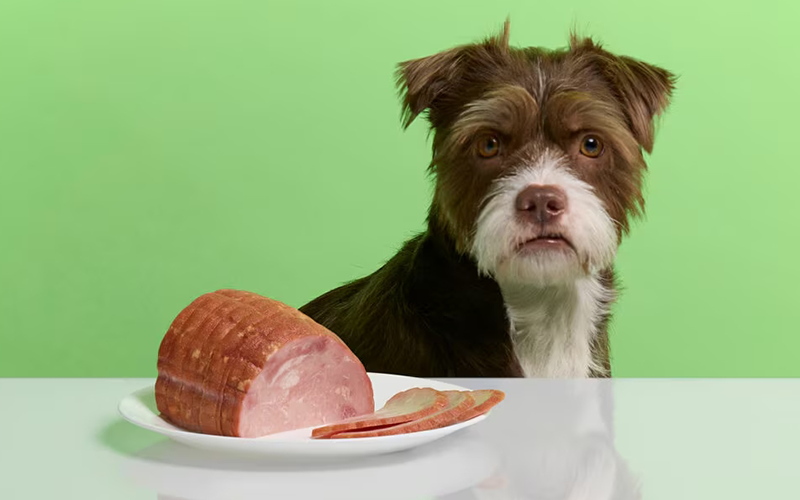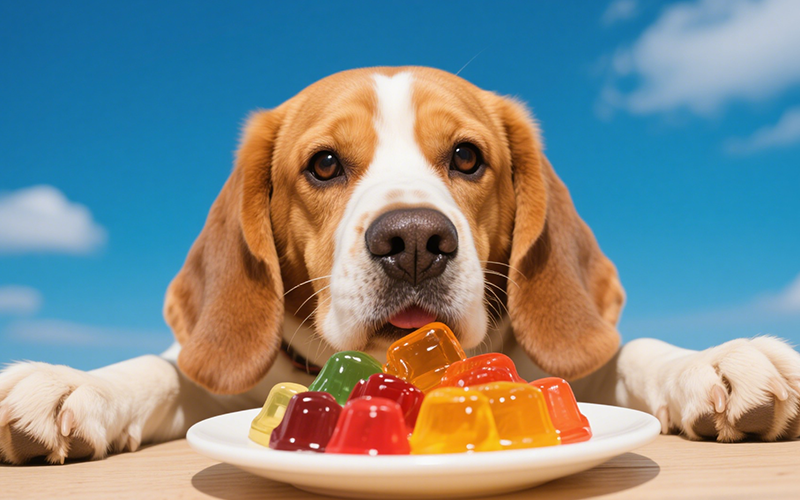Can Dogs Eat Ham? Understanding the Risks and Benefits of Feeding Ham to Your Dog
- 20 Feb 2025 11:42
As pet owners, we love to share our food with our furry companions, especially during holidays or family gatherings. Ham is a popular dish, but you may be wondering: can dogs eat ham? While ham isn’t necessarily toxic to dogs, it’s not the best food for them. There are several risks and considerations when it comes to feeding ham to your dog. Let’s explore whether ham is safe for dogs, what potential risks it poses, and what alternatives you might consider.

Why Ham Isn’t Ideal for Dogs
High in Salt
One of the biggest concerns with ham is its high salt content. Most ham sold in stores or served at meals is heavily salted to enhance flavor and preserve the meat. Excessive salt can lead to a condition known as salt poisoning, which can cause symptoms like vomiting, diarrhea, excessive thirst, urination, and even more severe conditions like kidney damage or seizures if consumed in large amounts. Dogs that eat too much salt can experience elevated blood pressure and dehydration, which can affect their overall health.Fatty Meat
Ham is also quite fatty, which can be difficult for some dogs to digest. While dogs need fat in their diet, too much fatty meat can lead to digestive upset, obesity, and pancreatitis (inflammation of the pancreas). Dogs who are overweight or prone to pancreatitis should avoid fatty meats like ham, as it can exacerbate these conditions.Bones and Bone Fragments
Many types of ham have bones, or small fragments that could pose a choking hazard or cause internal injury if swallowed. If a dog consumes a bone, it could potentially splinter, leading to blockages in the digestive system or even causing tears in the intestines. Always be cautious with bones, as they can be dangerous for your dog, even if they seem soft or easy to chew.Processed Ingredients
Ham is often processed with preservatives, sugars, or other additives, which may not be healthy for dogs. Some types of ham are also glazed with sweeteners or spices, such as honey or maple syrup, which can be harmful to dogs. Sugary foods can lead to weight gain, diabetes, and dental issues, while certain spices and seasonings (like garlic and onion) are toxic to dogs.
Potential Health Risks of Feeding Ham to Dogs
Feeding your dog ham can lead to several health issues, especially if it’s a regular part of their diet or if they consume too much at once. Here are some risks to keep in mind:
Salt Poisoning (Hypernatremia)
High salt intake is one of the biggest dangers associated with ham. Dogs that consume too much salt may develop hypernatremia, a condition where the salt levels in the bloodstream become dangerously high. This can lead to severe dehydration, kidney problems, and neurological symptoms like confusion or seizures. In extreme cases, salt poisoning can be fatal.Pancreatitis
Fatty foods like ham can trigger pancreatitis, which occurs when the pancreas becomes inflamed. This condition is painful and can cause vomiting, diarrhea, lethargy, and loss of appetite. In severe cases, pancreatitis can be life-threatening, requiring intensive veterinary care.Obesity
Since ham is high in both fat and calories, feeding it regularly to your dog can contribute to weight gain. Obesity is a major health concern for dogs, leading to an increased risk of diabetes, joint problems, and heart disease. If your dog is overweight, it’s best to avoid feeding them fatty foods like ham.Choking or Internal Injury
As mentioned earlier, ham bones can be dangerous for dogs. If your dog is given a ham bone, it could splinter or break into sharp fragments that might puncture the digestive tract or cause blockages. Always avoid giving your dog bones from any cooked meat.
How to Safely Serve Ham to Your Dog (If You Choose to Do So)
If you do decide to give your dog a small amount of ham as an occasional treat, there are a few things you can do to reduce the risk:
Serve in Moderation
The key to feeding ham safely to your dog is moderation. A small amount, like a small bite or two, is unlikely to cause harm in a healthy dog. However, ham should never replace a balanced, nutritious diet, and it should only be offered as an occasional treat.Avoid Ham with Seasonings or Glazes
If you’re offering ham to your dog, make sure it’s plain and unseasoned. Avoid any ham that’s been processed with sugars, honey, or glazes, and definitely stay away from ham that contains garlic, onion, or other toxic ingredients. Stick to basic, unseasoned ham, and remove any skin, bones, or fatty pieces before serving it to your dog.Cut into Small, Manageable Pieces
If you’re serving ham to your dog, be sure to cut it into small pieces to avoid any choking hazards. Avoid giving them large chunks of ham, especially if your dog tends to gulp down food quickly.Monitor for Any Reactions
After offering ham to your dog for the first time, watch for any signs of digestive upset or allergic reaction, such as vomiting, diarrhea, or lethargy. If your dog experiences any adverse effects, discontinue feeding them ham and consult with a vet.
What to Do if Your Dog Eats Too Much Ham
If your dog has consumed too much ham, or if you suspect they may have ingested something harmful, it's important to take action quickly. Here's what you can do:
Contact Your Vet Immediately
If your dog has eaten a large amount of ham, especially if it contains bones or seasonings, contact your veterinarian or a pet health assistant like PettureX immediately. Your vet may recommend inducing vomiting, monitoring your dog for symptoms of salt poisoning or pancreatitis, or bringing your dog in for an exam.Watch for Symptoms of Salt Poisoning or Pancreatitis
Symptoms of salt poisoning include excessive thirst, vomiting, diarrhea, or lethargy. If your dog shows signs of pancreatitis, such as vomiting, abdominal pain, or lack of appetite, seek veterinary attention as soon as possible.Monitor Your Dog’s Health
Even if your dog doesn’t show immediate signs of illness, keep a close eye on them for the next 24-48 hours. If you notice anything unusual, don’t hesitate to contact your vet.
Healthier Alternatives to Ham
If you want to share a protein-packed treat with your dog, there are plenty of healthier alternatives to ham. Here are some dog-friendly options:
Chicken (boneless, skinless) – Lean chicken is a great source of protein that most dogs love. It’s much lower in fat than ham and doesn’t carry the same risks.
Turkey (plain, no seasoning) – Like chicken, turkey is another lean protein that is safer for dogs when served in moderation.
Lean beef – If your dog enjoys meat, lean cuts of beef can be a good option in moderation.
Carrots – A low-calorie, crunchy alternative that many dogs enjoy.
Sweet potatoes – Rich in fiber and nutrients, sweet potatoes are a great treat for your dog.
The Role of PettureX in Managing Your Dog’s Health
If you're ever uncertain about whether a food is safe for your dog, tools like PettureX can provide real-time consultation and guidance. PettureX offers 24-hour online support for all pet health-related concerns, including advice on diet, food safety, and emergency situations. With PettureX, you can rest assured that you’ll receive quick, accurate guidance when you need it most.
Conclusion: Can Dogs Eat Ham?
In conclusion, while dogs can technically eat ham, it’s not an ideal food for them due to its high salt content, fat levels, and potential to cause digestive issues or more serious health concerns. If you do choose to give your dog ham, it should be an occasional treat and served in moderation, without any bones, skin, or seasonings.
For your dog’s health and well-being, consider safer alternatives like lean meats or vegetables, and always consult with your vet or a pet health assistant like PettureX if you have any concerns. By being mindful of what you feed your dog, you can ensure they stay healthy, happy, and safe.
Related

Can Dogs Eat Peaches? Vet Explains Benefits, Cyanide Risks & Safe Serving
- 16 Apr 2025
Can Dogs Eat Mulberries? Vet Explains Safety, Benefits & Potential Risks
- 16 Apr 2025
Can Dogs Eat Mozzarella? Vet Explains the Cheesy Truth (Risks & Benefits)
- 16 Apr 2025
Can Dogs Eat Mango Skin? Vet Explains Why It's a Risky Chew!
- 16 Apr 2025
Can Dogs Eat Maple Syrup? The Sugary Truth & Why Vets Advise Against It
- 16 Apr 2025
Can Dogs Eat Mac n Cheese? Vet Explains Why This Comfort Food Is Unsafe!
- 16 Apr 2025
Can Dogs Eat Liver? Vet Guide to This Nutrient-Dense Organ Meat (Benefits & Risks!)
- 16 Apr 2025
Can Dogs Eat Licorice? The Sweet Danger & Glycyrrhizin Risk Explained by Vets
- 16 Apr 2025
Can Dogs Eat Lamb? Vet Insights on This Nutritious Meat Option
- 16 Apr 2025
Can Dogs Eat Jelly? The Sweet Truth About Sugar, Xylitol & Why Vets Say No!
- 16 Apr 2025
